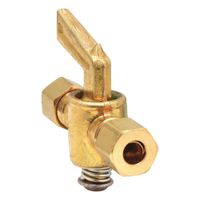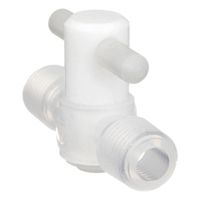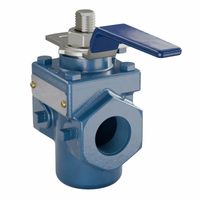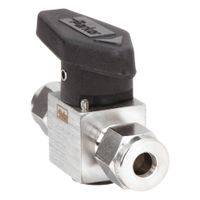Call +(254) 703 030 000 / 751 483 999 / 721 704 777
- Home
- Plumbing
- Plumbing Valves
- Shut Off Valves
- Plug Valves
Plug Valves
Plug valves are a quarter-turn, shut-off valve that quickly stops and starts media flow. The valve's plug provides fast-closing action and a large sealing surface to prevent leak paths. Ground plug valves are used in low-pressure applications and are typically connected to air and water lines. Instr .....Read More
Frequently Asked Questions
What are plug valves used for?
Plug valves are used to control the flow of fluids in various industrial applications. They are quarter-turn valves that utilize a cylindrical or conically tapered plug to regulate fluid passage. The plug has one or more hollow passageways, allowing fluid to flow through the valve when aligned with the inlet and outlet ports. When the plug is turned, the passageways are blocked, stopping the flow.
Plug valves are commonly used in applications requiring quick and frequent operation, as they provide a simple and reliable mechanism for on/off control. They are suitable for handling a wide range of fluids, including gases, slurries, and liquids, and are often employed in industries such as oil and gas, chemical processing, water treatment, and power generation.
These valves are particularly advantageous in applications where tight shutoff is necessary, as they offer minimal leakage when closed. They are also favored for their durability and ability to handle high-pressure and high-temperature conditions. Additionally, plug valves are often used in applications where space is limited, as their compact design allows for easy installation in tight spaces.
In summary, plug valves are versatile components used for controlling fluid flow in various industrial settings, offering reliable performance, quick operation, and effective sealing capabilities.
How do plug valves work?
Plug valves work by using a cylindrical or conically tapered plug to control fluid flow through a pipe. The plug has a hole or passageway that aligns with the flow path when the valve is open, allowing fluid to pass through. When the plug is rotated 90 degrees, the passageway is perpendicular to the flow path, blocking the flow and closing the valve.
The valve body houses the plug, which is rotated using a handle or actuator. The plug fits snugly within the valve body, and its rotation is facilitated by a lubricant or a non-lubricated design, such as a sleeved plug valve. The tight fit ensures a good seal, preventing leaks when the valve is closed.
Plug valves are known for their simple design, quick operation, and ability to provide a tight seal. They are commonly used in applications requiring frequent operation, such as in pipelines for oil and gas, chemical processing, and water treatment. The valves can handle a range of fluids, including gases, slurries, and liquids with suspended solids.
There are different types of plug valves, including lubricated, non-lubricated, eccentric, and multi-port designs, each suited for specific applications. Lubricated plug valves use a lubricant to reduce friction and wear, while non-lubricated valves use a sleeve or liner to achieve a similar effect. Eccentric plug valves have an offset plug for better sealing and reduced wear, and multi-port plug valves allow for flow direction changes without additional valves.
Overall, plug valves are valued for their durability, reliability, and ease of maintenance, making them a popular choice in various industrial settings.
What are the different types of plug valves?
1. **Lubricated Plug Valves**: These valves use a lubricant to reduce friction between the plug and the body, making them suitable for high-pressure applications. The lubricant also helps seal the valve and prevent leakage.
2. **Non-Lubricated Plug Valves**: These valves do not require lubrication. They often use a sleeve or liner made of materials like PTFE to reduce friction. They are ideal for applications where contamination from lubricants must be avoided.
3. **Eccentric Plug Valves**: These have a plug that is offset from the center, allowing for a camming action that reduces wear and provides a tight seal. They are used in applications with abrasive or corrosive media.
4. **Expanding Plug Valves**: These valves have a mechanism that expands the plug against the body to create a tight seal. They are used in applications requiring double block and bleed capabilities.
5. **Multi-Port Plug Valves**: These valves have multiple ports and can be used to divert flow in different directions. They are useful in complex piping systems where flow needs to be directed to various outlets.
6. **Sleeved Plug Valves**: These feature a sleeve that encases the plug, providing a tight seal and reducing friction. They are suitable for handling corrosive or abrasive fluids.
7. **Lined Plug Valves**: These valves have a lining, often made of materials like rubber or PTFE, to protect the valve body from corrosive or abrasive media. They are used in chemical processing and other harsh environments.
8. **Double Block and Bleed Plug Valves**: These provide two seating surfaces for isolation and a bleed port for venting or draining. They are used in applications requiring high integrity isolation.
What materials are plug valves made from?
Plug valves are made from a variety of materials, each chosen based on the specific application, operating conditions, and the type of fluid being handled. Common materials include:
1. **Cast Iron**: Used for low-pressure applications and non-corrosive fluids. It is cost-effective and provides good mechanical strength.
2. **Ductile Iron**: Offers better strength and toughness compared to cast iron, suitable for higher pressure applications.
3. **Carbon Steel**: Ideal for high-pressure and high-temperature applications. It is durable and can handle a wide range of fluids.
4. **Stainless Steel**: Provides excellent corrosion resistance, making it suitable for corrosive fluids and environments. Common grades include 304 and 316 stainless steel.
5. **Bronze**: Used in applications involving water, seawater, and other non-corrosive fluids. It offers good corrosion resistance and is often used in marine environments.
6. **Brass**: Suitable for low-pressure applications and non-corrosive fluids. It is often used in plumbing and water systems.
7. **Alloy Steels**: Used for high-temperature and high-pressure applications. They offer enhanced mechanical properties and corrosion resistance.
8. **Monel**: A nickel-copper alloy known for its excellent corrosion resistance, especially in marine and chemical environments.
9. **Hastelloy**: A nickel-molybdenum alloy that provides superior corrosion resistance in harsh chemical environments.
10. **Plastic and Thermoplastics**: Materials like PVC, CPVC, and PTFE are used for low-pressure applications involving corrosive chemicals. They offer excellent chemical resistance and are lightweight.
11. **Ceramics**: Used in highly abrasive or corrosive environments, providing excellent wear and corrosion resistance.
The choice of material depends on factors such as pressure, temperature, fluid characteristics, and environmental conditions.
How do you maintain a plug valve?
To maintain a plug valve, follow these steps:
1. **Regular Inspection**: Periodically inspect the valve for signs of wear, corrosion, or damage. Check for leaks around the valve body and stem.
2. **Cleaning**: Clean the valve exterior to remove dirt, debris, and any corrosive substances. Ensure the plug and body are free from deposits that could hinder operation.
3. **Lubrication**: Apply appropriate valve lubricant to the plug and stem to ensure smooth operation. Use a grease gun to inject lubricant through the valve's grease fittings if available.
4. **Operation Check**: Cycle the valve open and closed to ensure it moves smoothly. This helps distribute lubricant and identifies any operational issues.
5. **Tightening**: Check and tighten any loose bolts or nuts on the valve body and flange connections to prevent leaks.
6. **Seal Inspection**: Examine the seals and gaskets for wear or damage. Replace them if necessary to maintain a proper seal and prevent leaks.
7. **Corrosion Protection**: Apply a protective coating to the valve body if it is exposed to corrosive environments to prevent rust and degradation.
8. **Leak Testing**: Perform leak tests periodically to ensure the valve is sealing properly. Use appropriate testing methods such as pressure testing.
9. **Documentation**: Keep records of maintenance activities, including inspections, lubrication, and any parts replaced. This helps track the valve's condition over time.
10. **Training**: Ensure personnel are trained in proper valve maintenance procedures to prevent damage and ensure safety.
By following these steps, you can extend the life of a plug valve and ensure its reliable operation.
What are the advantages of using plug valves?
Plug valves offer several advantages:
1. **Simple Design**: They have a straightforward design with fewer parts, which makes them easy to operate and maintain.
2. **Quick Operation**: Plug valves provide quick on-off action, which is beneficial in applications requiring fast shutoff.
3. **Versatility**: They can handle a wide range of fluids, including gases, liquids, and slurries, making them suitable for various industries.
4. **Tight Sealing**: The design allows for a tight seal, reducing the risk of leaks and ensuring efficient flow control.
5. **Durability**: Made from robust materials, plug valves are durable and can withstand harsh conditions, including high pressure and temperature.
6. **Minimal Flow Resistance**: The straight-through flow path minimizes pressure drop and flow resistance, enhancing system efficiency.
7. **Bi-directional Flow**: They allow flow in both directions, providing flexibility in system design and operation.
8. **Low Maintenance**: Due to their simple construction and fewer moving parts, plug valves require less maintenance compared to other valve types.
9. **Compact Size**: Their compact design makes them suitable for installations with space constraints.
10. **Variety of Configurations**: Available in various configurations, including multi-port designs, plug valves can be customized to meet specific application needs.
11. **Corrosion Resistance**: Often made from materials resistant to corrosion, they are ideal for corrosive environments.
12. **Cost-Effective**: Their simplicity and durability make them a cost-effective choice for many applications.
These advantages make plug valves a popular choice in industries such as oil and gas, chemical processing, and water treatment.
In which industries are plug valves commonly used?
Plug valves are commonly used in the following industries:
1. **Oil and Gas Industry**: Plug valves are extensively used in upstream, midstream, and downstream operations for controlling the flow of crude oil, natural gas, and refined products. They are favored for their ability to handle high-pressure and high-temperature applications.
2. **Chemical and Petrochemical Industry**: These valves are used to manage the flow of various chemicals and petrochemicals, including corrosive and hazardous substances, due to their robust construction and ability to provide a tight seal.
3. **Water and Wastewater Treatment**: Plug valves are employed in water treatment plants for controlling the flow of water and sludge. Their simple design and ease of maintenance make them suitable for these applications.
4. **Power Generation**: In power plants, plug valves are used in systems that require reliable shut-off and control, such as in cooling water systems, fuel handling, and steam systems.
5. **Pharmaceutical Industry**: The valves are used in processes that require strict hygiene standards and precise flow control, as they can be easily cleaned and maintained.
6. **Food and Beverage Industry**: Plug valves are utilized in processing lines where sanitary conditions are essential. They are used for handling liquids, gases, and slurries in food production.
7. **Pulp and Paper Industry**: These valves are used in the processing of pulp and paper, where they handle abrasive and viscous fluids, providing reliable operation in harsh conditions.
8. **Mining Industry**: Plug valves are used in mining operations to control the flow of slurries and other abrasive materials, offering durability and resistance to wear.
9. **HVAC Systems**: In heating, ventilation, and air conditioning systems, plug valves are used for regulating the flow of air and fluids, ensuring efficient system operation.



